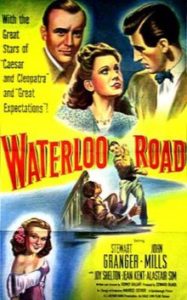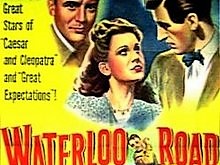Waterloo Road **** (1945, John Mills, Stewart Granger, Alastair Sim, Joy Shelton, Jean Kent, Beatrice Varley, Alison Leggatt) – Classic Movie Review 6964
Director Sidney Gilliat’s 1945 British black and white wartime romantic drama movie Waterloo Road for Gainsborough Pictures stars John Mills as English soldier Jim Colter, who is called up to fight in World War Two. But then he deserts to get to his home near London’s Waterloo station after he discovers that his wife Tillie (Joy Shelton) is having an affair with a cad and a bounder, Ted Purvis (Granger), who has forged a phony doctor’s certificate to avoid military combat. It ends up in an epic fight scene.
Waterloo Road is warm and entertaining, with two strong, impressive star performances from the battling protagonists Mills and Granger, and equally impressive work from a fine ensemble, including Alastair Sim as Dr Montgomery, Leslie Bradley, George Carney, Beatrice Varley, Alison Leggatt and Jean Kent.
It is the third in an unofficial trilogy by Gilliat, preceded by Millions Like Us (1943) and Two Thousand Women (1944).
Also in the cast are Wylie Watson, Ben Williams, Anna Konstam, Vera Francis, George Merritt, Johnnie Schofield, Dennis Harkin, Peter Hammond, Ian Fleming, Arthur Denton, John Boxer, Frank Atkinson, Nellie Bowman, David Crowley, Amy Dalby and Mike Johnson.
Waterloo Road is directed by Sidney Gilliat, runs 77 minutes, is produced by Gainsborough Pictures, is released by General Film Distributors, is written by Sidney Gilliat and Val Valentine, based on their story, is shot in black and white by Arthur Crabtree and Phil Grindrod, is produced by Maurice Ostrer and Edward Black, scored by Louis Levy, and designed by Alex Vetchinsky.
It was shot at Gainsborough Studios, Islington, London, England.
It was released on 9 January 1945 in the UK but not till 24 December 1948 in New York City.
Granger recalled it as one of the favourites of his films as his role ‘was a heel, but a real character’. It was made in ten days while he was making Love Story and he was especially proud of his fight scene with Mills.
Gilliat said he added the idea of using Sim’s character Dr Montgomery as a commentator but thought it ‘a bit of a mess’. Gilliat recalled he was removed from the film when production was stopped before it was finished and there were still some exteriors to be shot. Producer Edward Black had departed and Maurice Ostrer put the film at the back of the dubbing schedule, but luckily Earl St John, the boss of Odeon cinemas, admired the film and ordered the dubbing finished.
Kent and Granger also made Fanny by Gaslight (1944), Madonna of the Seven Moons (1945), Caravan (1946) and The Magic Bow (1946) together.
© Derek Winnert 2018 Classic Movie Review 6964
Check out more reviews on http://derekwinnert.com



